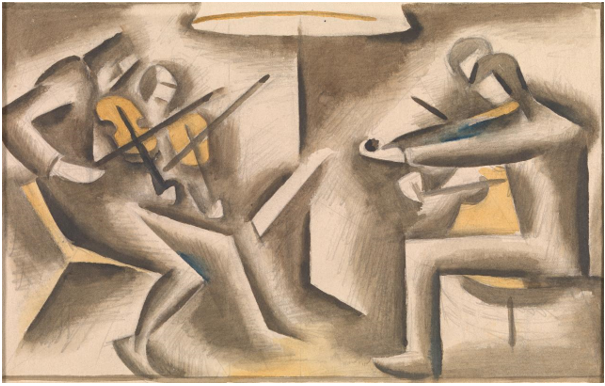Interpreting and reviewing visual artworks is a key element of the Visual Arts curriculum. Students must generate their own interpretations and reviews of artworks and consider others' interpretations of artworks.
However written interpretations of artworks may have sophisticated language and sentence structures. It is helpful for teachers to deconstruct interpretation responses at both the sentence and whole-text level. In the first instance, this should support students reading and comprehension; in the second, it should improve the writing of their own interpretations of artworks.
Unpacking expanded noun (nominal) groups
A noun or nominal group is a group of words that represents or provides information about something (e.g. places, things, ideas) or someone, whether concrete (i.e. physical entity, such as an apple) or abstract (i.e. concept or idea, such as hunger) in a clause.
A noun group can include a single word (such as 'artwork') or be expanded to include pre- and/or post-modifiers which provide clear details about the head noun (such as 'the new artwork which depicts city life'). The pre-modifier 'new' shows that the artwork has been recently created, while the post-modifier 'which depicts city life' describes the subject matter of the work.
The sentences below relate to
Dorrit Black's
Study for The quartette (1936). The expanded noun group in each has been colour coded. The head noun is pink, the pre-modifiers in blue, and the post-modifiers (also called qualifiers) are in yellow.
Simplified shapes scaffolded by strong horizontal and vertical lines compose the pictorial structure of Dorrit Black's
Study for The quartette.
The sharp opposing diagonals in the figures on the left make them seem full of energy.

Dorrit Black
Study for The quartette (1936)
watercolour over pencil
15.1 × 24.6 cm (image) 19.2 × 28.1 cm (sheet)
National Gallery of Victoria, Melbourne
Purchased NGV Foundation, 2016
Photo: National Gallery of Victoria, Melbourne
Using expanded noun groups adds description and detailed information. (Compare the above sentence with 'Shapes compose …'). Teachers can explicitly teach students the components of expanded noun groups to improve their reading comprehension and writing.
To do this, teachers can encourage students to:
- Highlight (or circle) the head noun in one colour
- Highlight in another colour (or underline) pre-modifiers
- Highlight in yet another colour (or underline with a squiggly line) post-modifiers (Qualifiers).
Curriculum links for the above examples:
VCAVAE034,
VCAVAR038,
VCAVAE041,
VCAVAR045.
Jointly deconstructing interpretation responses
Jointly deconstructing interpretation responses supports students 'to identify the themes or key ideas of a text or artwork and respond to its values' (Derewianka & Jones, 2016 p. 266). To jointly deconstruct an interpretation, teachers can use coding to identify the various elements used in Media Arts analyses.
A similar strategy can be used to jointly deconstruct the art reviews, which is the focus of the
Visual Arts: Putting it together section.
The typical structure of an interpretation is:
- Theme Identification and preview of element
- Element evaluation
- Theme reiteration (Derewianka & Jones, 2016 p. 266).
Many of the language features of persuasive writing are relevant to interpretation responses and critical to responding, for example, language choices with attitude, such as those that express feelings, make judgements of behaviours, or evaluate qualities. These attitudes can be amplified or softened through vocabulary choices which increase or decrease the intensity of a viewpoint.
To attend to these kinds of choices:
- The teacher explains that the purpose of an interpretation response in Visual Arts is to identify the key theme or idea of the artwork and provide comment on its values. They do this by selecting art elements to justify their interpretation of the intended effects on the audience or viewer (Derewianka & Jones, 2016, p. 266).
- The teacher presents a model text of a paragraph in an interpretation response to the class. This may need to be written by the teacher.
- The teacher reads the text aloud, pausing to clarify any unknown or ambiguous terms.
- The teacher asks students to highlight:
- the key theme or idea (for example, in blue)
- art elements and choices in another colour (green)
- prepositional phrases which provide details of place (bolded) or adverbials of manner (italics)
- amplified adverbs or adjectives which express attitude (bold italics)
- complex or expanded noun groups (underlined)
- intended consequences (or effects) in yet another colour (yellow).
- The teacher leads a discussion, encouraging students to explain:
- how the topic sentence is supported by elaborations
- how the art elements are used to realise intended values
- Students can later use the deconstructed paragraph as a model for their own writing.
In the below example, a teacher created the model text of the analysis of
Black's
The study for The quartette (1936). The text has been highlighted according to the colour-coding above.
Dorrit Black's
Study for The quartette (1936) is a
dynamic image that uses lines to create a sense of movement and energy. The study comprises four musicians composed of
simplified shapes made up of various
horizontal, vertical and diagonal lines. The
sharp opposing diagonals in the figures on the left
make them seem
full of energy. The viewer's gaze is first drawn
to these
energetic figures and then guided
to the central top
by the musicians'
bows, where the lampshade redirects the eye
down
to the figures on the right side, who seem to be performing
less frenetically. Rather than resting there, the viewer's gaze is invited to follow the extended
violin, returning
to the left side of the image to continue to dance
around the image as the musicians play.
Note: Prepositional phrases can expand the noun groups as post-modifiers (or qualifiers), as in the example, "the sharp opposing diagonals
in the figures on the left", where 'diagonals' is the head noun and 'in the figures on the left' is the prepositional phrase that explains which figures the writer is describing.
Curriculum links for the above examples:
VCAVAE034,
VCAVAR038,
VCAVAE041,
VCAVAR045.